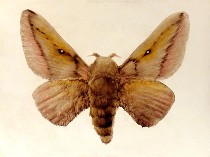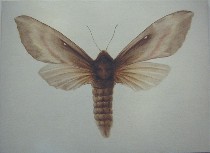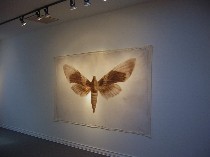 The moths that Kate Javens has painted and is exhibiting at SchmidtDean Gallery might fool you into believing they represent a reprise of Victorian taxonomy. After all, there they are, splayed and described, isolated on the picture plane, their backgrounds not quite white and barely uneven, like aging paper or even like skin (left, “YP,” oil on wood, 18″ x 24″).
The moths that Kate Javens has painted and is exhibiting at SchmidtDean Gallery might fool you into believing they represent a reprise of Victorian taxonomy. After all, there they are, splayed and described, isolated on the picture plane, their backgrounds not quite white and barely uneven, like aging paper or even like skin (left, “YP,” oil on wood, 18″ x 24″).But the description is open to interpretation; it’s neither photographic nor dictated only by the taxonomical concern of species differentiation, even though the paintings were made from pinned specimens.
Just compare them to an Audobon bird, which is crisp and labeled, hard-edged, closely observed and cool.
These moths are surely something else. As in Javens’ past images of beasts, the moths are isolated in the struggle for survival–which they have lost.Their fuzziness is painted like locks of hair, slightly mussed–too tender and specific a description for mere moths. The moths have dignity.
 Yet the human metaphor is hard won from dead moths, which repel with their creepiness and insecthood. And with this struggle between identification and rejection lies the power of these paintings. Perhaps we humans aren’t all that swell afterall; perhaps we too repel at the same time that we astonish with our bells and whistles and uniqueness. Looking back at her past work, I couldn’t help but wonder if Javens’ bulls and horses were also intended to repel, but that somehow I missed it (right, “C Sphinx,” oil on linen on wood, 18″ x 24″; the moth’s sphinx-like “face” and pokey bottom belong in a horror movie).
Yet the human metaphor is hard won from dead moths, which repel with their creepiness and insecthood. And with this struggle between identification and rejection lies the power of these paintings. Perhaps we humans aren’t all that swell afterall; perhaps we too repel at the same time that we astonish with our bells and whistles and uniqueness. Looking back at her past work, I couldn’t help but wonder if Javens’ bulls and horses were also intended to repel, but that somehow I missed it (right, “C Sphinx,” oil on linen on wood, 18″ x 24″; the moth’s sphinx-like “face” and pokey bottom belong in a horror movie).By taking this tough position between humanity and mothiness, the paintings, for all their Victorian references, remain thoroughly modern. I read the moths as a way to understand the vulnerability and loneliness of all creatures as they participate in life and death in a pitiless universe. Some of the moths, with their wings less stretched, look exhausted by the struggle.
 The judiciously applied paint is a real, but subtle presence in this work. Most of the paintings are small, about 10 to 20 inches.
The judiciously applied paint is a real, but subtle presence in this work. Most of the paintings are small, about 10 to 20 inches.
The decision to paint the largest of the work on theater muslin immediately raises questions about the artist’s intent. And the unstretched, pinned-to-the-wall muslin references the fate of the creatures themselves (left, “TAM, Sphinx,” oil on theater muslin, 66″ x 106″).









